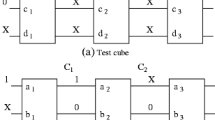Abstract
A new three-stage process for partial scan design is presented. The first two stages focus on cyclebreaking, and on limiting the maximum length of consecutive self-loops, as proposed by previous researchers. For the third stage, combinational blocks and their effects on sequential test generation are evaluated using a graphtheoretic representation designated the circuit flow graph. Costs calculated from the circuit flow graph representation are then used to select additional scan flip-flops. Sequential test generation results show that our selection of scan flip-flops is generally smaller than that reported by earlier researchers, and leads to a comparable fault coverage and smaller test generation time.
Similar content being viewed by others
References
E.B. Eichelberger and T.W. Williams, “A logic design structure for LSI testability,”Journal of Design Automation and Fault Tolerant Computing, pp. 165–178, May 1978.
K.-T. Cheng and V.D. Agrawal, “A partial scan method for sequential circuits with feedback”,IEEE Transactions on Computers, Vol. 39, pp.544–548, April 1990.
R. Gupta, R. Gupta, and M.A. Breuer, “The ballast methodology for structured partial scan”,IEEE Transactions on Computers, Vol. 39, pp.538–544, April 1990.
D.H. Lee and S.M. Reddy, “On determining scan flip-flops in partial scan designs”, inProceedings of the ICCAD, pp. 322–325, November 1990.
E. Trischler, “Incomplete scan path with an automatic test generation methodology”, inProceedings of the International Test Conference, pp. 153–162, November 1980.
H.-J. Wunderlich, “The design of random-testable sequential circuits”, inProceedings of the 19th International Symposium on Fault-Tolerant Computing, pp. 110–117, June 1989.
S.-E. Tai and D. Bhattacharya, “A three-stage partial scan design method using the sequential circuit flow graph”, inProceedings of the 7th International Conference on VLSI Design, pp. 101–106, January 1994.
S.-E. Tai and D. Bhattacharya, “Pipelined fault simulation on parallel machines using the circuit flow graph”, inProceedings of the International Conference on Computer Design, pp. 564–567, October 1993.
F. Brglez, D. Bryan, and K. Kozminski, “Combinational profiles of sequential benchmark circuits”, inProceedings of the IEEE International Symposium on Circuits and Systems, pp. 1929–1934, May 1989.
R.M. Karp, “Reducibility among combinatorial problems”, inComplexity of Computer Computations, R.E. Miller and J.W. Thatcher (eds.), pp. 85–103, New York, NY: Plenum Press, 1972.
S. Bhawmik, C.J. Lin, K.-T. Cheng, and V.D. Agrawal, “PASCANT: A partial scan and test generation system”, inProceedings of the 1991 Custom Integrated Circuits Conference, pp. 17.3.1–17.3.4, June 1991.
E.L. Lloyd, M.L. Soffa, and C.-C. Wang, “On locating minimum feedback vertex sets”,Journal of Computer and System Sciences, Vol. 37, pp. 292–311, 1988.
G.W. Smith and R.B. Walford, “The identification of a minimal feedback vertex set of a directed graph”,IEEE Transaction on Circuits and Systems, Vol. CAS-22, pp. 9–15, January 1975.
B. Bencivenga, T. Chakrabarty, and S. Davidson, “Gentest: The architecture of sequential circuit test generator”, inProceedings of Custom Integrated Circuits Conference, pp. 17.1.1–17.1.4, May 1991.
S. Patil and P. Banerjee, “TGEN: An automatic test pattern generator for sequential circuits”, Tech. Rep., University of Illinois, Urbana-Champaign, IL, April 1990.
Author information
Authors and Affiliations
Rights and permissions
About this article
Cite this article
Tai, SE., Bhattacharya, D. A three-stage partial scan design method to ease ATPG. J Electron Test 7, 95–104 (1995). https://doi.org/10.1007/BF00993317
Received:
Revised:
Issue Date:
DOI: https://doi.org/10.1007/BF00993317




